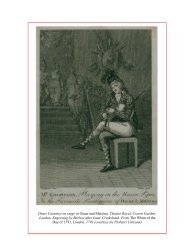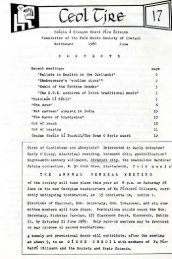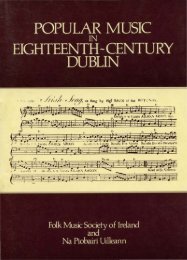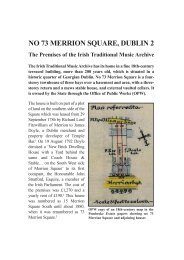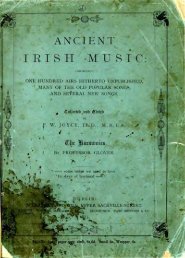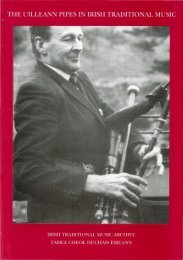Union Pipes - Irish Traditional Music Archive
Union Pipes - Irish Traditional Music Archive
Union Pipes - Irish Traditional Music Archive
You also want an ePaper? Increase the reach of your titles
YUMPU automatically turns print PDFs into web optimized ePapers that Google loves.
COUrTney’S ‘UnIOn PIPeS’ AnD The TerMInOlOgy OF IrISh BellOWS-BlOWn BAgPIPeS 54<br />
The instrument shown also seems undeveloped in the light of the earliest<br />
known physical description of the ‘<strong>Irish</strong> pipes’. This was of a set that in<br />
1774 belonged to the Cork piper James McDonnell, the same who, as<br />
already noticed, played with Courtney before the highland Society of<br />
london in 1791 and played the ‘<strong>Irish</strong> pipes’ in recital in london in 1793<br />
during Courtney’s absence in Ireland. McDonnell also played seated.<br />
his pipes in 1774 were ‘small and of ivory... tipped with silver and<br />
gold... [as well as ‘the chanter or treble’] there are three other pipes<br />
which hang over the wrist. The longest of them is called the drone or<br />
bass.’ 161 Again as seen, since Courtney played with John Murphy before<br />
the highland Society of london in early 1788, and since Murphy played<br />
a set of ‘<strong>Irish</strong> Bag-pipes, by the real old egan in Dublin, made for a nobleman<br />
deceased’, it is inconceivable that Courtney played on an<br />
instrument inferior to Murphy’s, given that he would have a resounding<br />
london stage success within a week of their second performance. It<br />
also seems inconceivable that Courtney’s Dublin successes of 1793<br />
could have been achieved on an instrument as undeveloped as the one<br />
shown in Cruikshank’s illustration, when played for <strong>Irish</strong> audiences who<br />
were used to more sophisticated instruments. Courtney had been absent<br />
from london from the beginning of the year in which the illustration<br />
was published: it is likely therefore that Cruikshank had been forced to<br />
draw from memory and had fallen back on a stock bagpipe image. The<br />
probability must be therefore that the drawing is not an accurate<br />
representation of the reality – in spite of the high reputation of the artist<br />
Cruikshank – as is so often the case with drawings of musical<br />
instruments, and especially the bagpipes, 162 by even the best artists.<br />
and instrumentalists such as violinists, flute players, oboeists and harpers also<br />
played successfully in the same spaces; the venue acoustics must have been<br />
finely balanced.<br />
161<br />
O’Keeffe 1826: I, 246–8, see Carolan 1984: 59–61.<br />
162<br />
See Cannon 1989: 10–31. The accuracy of a c. 1828 drawing by one of the<br />
Cruikshank family of the northumberland piper James Allan has been called



